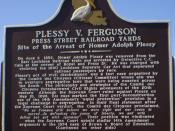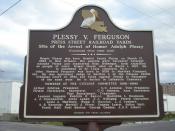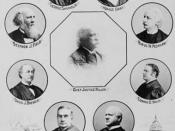Plessy V. Ferguson
In September 1891 a group of blacks in New Orleans, Louisiana, formed the Citizens Committee to Test the Constitutionality of the Separate Car Law. In June 1892 Homer Plessy sat in the car designated for whites only. Plessy was one-eighth black, but under Louisiana law he was considered black. The Citizens Committee alerted railroad officials that Plessy was sitting in the whites only car. Plessy was arrested and brought to court before Judge John H. Ferguson of the U.S. District Court in Louisiana. Plessy then attempted to halt the trial by suing Ferguson on the grounds that the segregation law was unconstitutional.
Plessy argued to the district court that the Separate Car Act violated the Thirteenth and Fourteenth Amendments to the Constitution. The Supreme Court decision of "separate but equal" emphasized segregation in public facilities. Although the ruling did not imply with the 13th amendment, which abolished slavery, and the 14th amendment, which guaranteed equal protection of law, it was able to prevent African - Americans from enjoying equal facility.
Furthermore, it put limitation on their individual rights and anything beneficial such as higher education which was not accessible to them.
During the course of the criminal trial, Plessy filed a writ of prohibition and petitioned the state supreme court to enjoin the trial judge, John Ferguson, from continuing the proceedings against him. Plessy claimed that his ancestry was seven-eighths Caucasian and one-eighth African blood. That the mixture of colored blood was not very much in him, and that he was entitled to every right, privilege, and immunity secured to citizens of the United States of the white race.
The state Supreme Court asked the respondent, Ferguson, to show a cause of why the writ of prohibition should not be issued to Plessy. Ferguson asserted the constitutionality...


